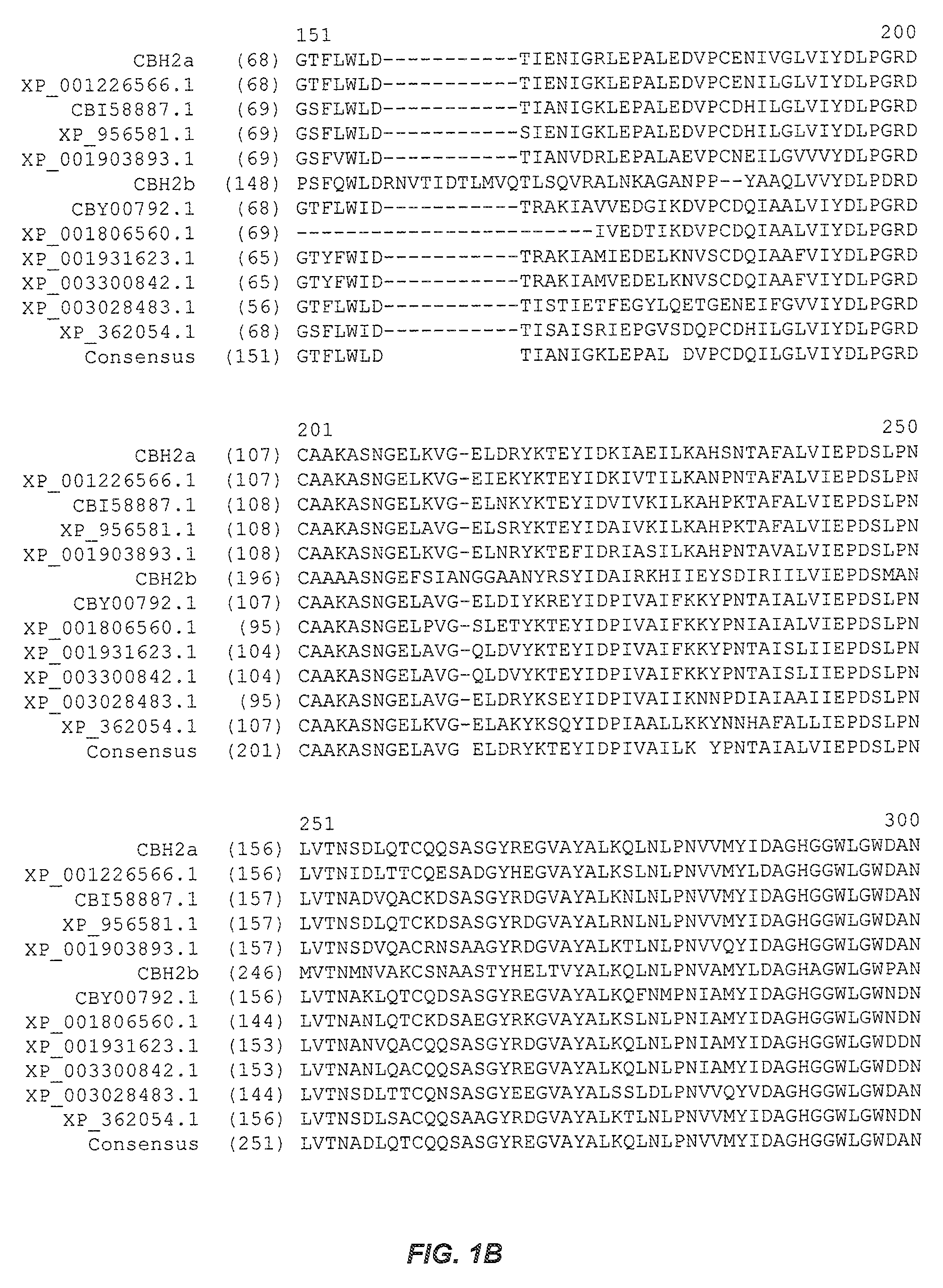Cellobiohydrolase variants
a technology of cellulosic biomass and variants, applied in the field of cellulosic biomass conversion to fermentable sugars, can solve the problem of challenging efficiency conversion of cellulosic biomass to fermentable sugars
- Summary
- Abstract
- Description
- Claims
- Application Information
AI Technical Summary
Benefits of technology
Problems solved by technology
Method used
Image
Examples
example 1
Wild-type M. thermophila CBH2a Gene Acquisition and Construction of Expression Vectors
[0287]The wild-type M. thermophila cellobiohydrolase type 2a (CBH2a) cDNA gene (SEQ ID NO:2) was cloned by PCR amplification from a cDNA library using vector-specific primers that flanked the inserts. The wild-type M. thermophila CBH2a sequence was cloned for expression in the Saccharomyces cerevisiae strain InvSc1, a commercially available strain (Invitrogen, Carlsbad, Calif.). A variant identified in the initial screening, Variant 22, was cloned for expression in the Saccharomyces cerevisiae strain InvSc1.
example 2
Assays to Determine Cellobiohydrolase Thermostability
[0288]Cellobiohydrolase thermostability may be determined by exposing the cellobiohydrolase to stress conditions of elevated temperature, optionally at low pH, for an appropriate period of time and then determining residual cellobiohydrolase activity by a cellulose assay.
[0289]The cellobiohydrolase was challenged by incubating under conditions of pH 5 and 55° C. or 57° C. for 1 hour. Following the challenge incubation, residual activity of the cellobiohydrolase was measured.
[0290]Residual cellobiohydrolase activity was determined using a crystalline cellulose assay in which Avicel was used as a substrate. The reaction was incubated at 50° C., pH 5 for 16-24 hours in the presence of β-glucosidase. Activity was measured as glucose production using a GOPOD assay. 20 μl of the above reaction was mixed with 180 μl of GOPOD assay mix. The reactions were allowed to shake for at least 45 min at room temperature. Absorbance of the solution...
example 3
High Throughput Assays to Identify Improved M. thermophila CBH2a Variants
[0291]Variations were introduced into CBH2a cDNA sequences resulting in the generation of plasmid libraries containing variant cellobiohydrolase genes. The libraries were transformed into S. cerevisiae. Transformants were plated on SD-ura agar plate containing 2% glucose. After incubation for at least 48 hours at 30° C., colonies were picked using a Q-bot® robotic colony picker (Genetix USA, Inc., Beaverton, Oreg.) into shallow, 96-well well microtiter plates containing pH adjusted 200 μL SD-ura media and 3% glucose. Cells were grown for 24 hours at 30° C. with shaking at 250 rpm and 85% humidity. 20 μL of this overnight culture was then transferred into 96-well microtiter plates (deep well) containing 380 μL DEMA Extra medium and 1% galactose. The plates were incubated at 37° C. with shaking at 250 rpm and 85% humidity for 48 hours. The deep plates were centrifuged at 4000 rpm for 15 minutes and the clear medi...
PUM
| Property | Measurement | Unit |
|---|---|---|
| pH | aaaaa | aaaaa |
| temperature | aaaaa | aaaaa |
| temperature | aaaaa | aaaaa |
Abstract
Description
Claims
Application Information
 Login to View More
Login to View More - R&D
- Intellectual Property
- Life Sciences
- Materials
- Tech Scout
- Unparalleled Data Quality
- Higher Quality Content
- 60% Fewer Hallucinations
Browse by: Latest US Patents, China's latest patents, Technical Efficacy Thesaurus, Application Domain, Technology Topic, Popular Technical Reports.
© 2025 PatSnap. All rights reserved.Legal|Privacy policy|Modern Slavery Act Transparency Statement|Sitemap|About US| Contact US: help@patsnap.com



